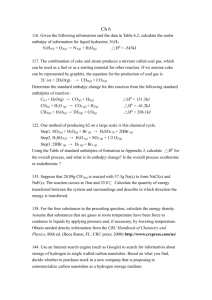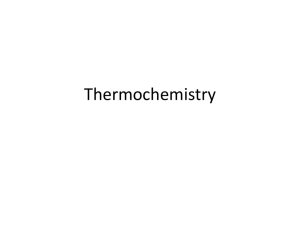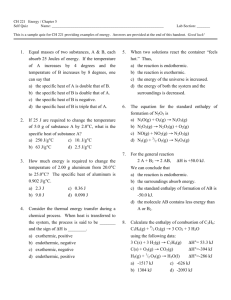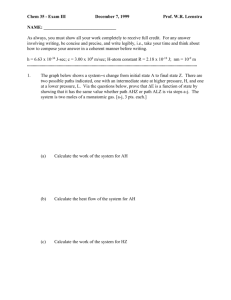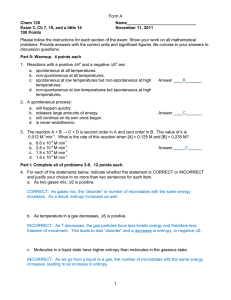Energy and Chemical Reactions
advertisement
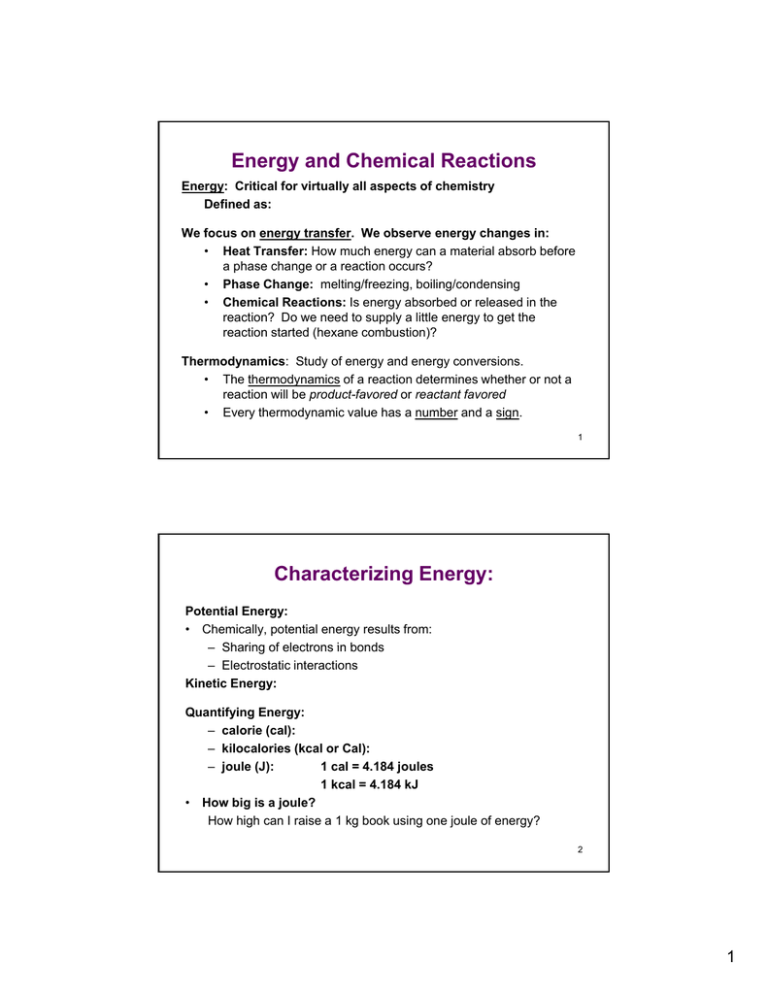
Energy and Chemical Reactions Energy: Critical for virtually all aspects of chemistry Defined as: We focus on energy transfer. transfer We observe energy changes in: • Heat Transfer: How much energy can a material absorb before a phase change or a reaction occurs? • Phase Change: melting/freezing, boiling/condensing • Chemical Reactions: Is energy absorbed or released in the reaction? Do we need to supply a little energy to get the reaction started (hexane combustion)? Thermodynamics: Study of energy and energy conversions. • The thermodynamics of a reaction determines whether or not a reaction will be product-favored or reactant favored • Every thermodynamic value has a number and a sign. 1 Characterizing Energy: Potential Energy: • Chemically, potential energy results from: – Sharing of electrons in bonds – Electrostatic interactions Kinetic Energy: Quantifying Energy: – calorie (cal): – kilocalories (kcal or Cal): – joule (J): 1 cal = 4.184 joules 1 kcal = 4.184 kJ • How big is a joule? How high can I raise a 1 kg book using one joule of energy? 2 1 Thinking about Energy A Few Key Terms: • system: specific part of the universe that we has our attention attention. • surroundings: everything else (everything that is not the system) • universe = system + surroundings. In general terms, energy is transferred between the system and the surroundings. We take the perspective of the system Energy in = positive Energy out = negative 3 Thinking about Energy Law of Conservation of Energy: VERY IMPORTANT, we rely on this! • At a given instant, a system has a fixed total energy: U= • We tend to focus on energy changes (Why?): – When working with energy changes, keep in mind that energy can be transferred in two ways: as heat, and as work U = – To simplify matters, we typically design experiments so that the work contribution is negligible (or at least understood) 4 2 Energy Transfer as Heat: Enthalpy Changes Enthalpy, H: Heat transfer at constant pressure Exothermic process: Heat is transferred from to q is Endothermic process: Heat is transferred from q is to H has the same sign as q s l, or l g phase changes are endothermic, positive H l s, or g l phase changes are exothermic, negative H 5 Energy Transfer as Heat: Heat ALWAYS moves from a hotter to a cooler object!!! • Q Quantity tit off heat h t transferred t f d depends d d on the th heat h t capacity it off the th object being transferred to. Heat Capacity: Heat Capacity is an extensive property Because of its extensive character, we must specify heat capacity on a mass basis Specific Heat Capacity (or specific heat): • May be defined on a per gram or per mole basis 6 3 A couple of examples: Example: If 24.1 kJ is used to warm a piece of aluminum with a mass of 250. g, what is the final temperature of the aluminum if its initial temperature p is 5.0o C? The specific p heat of aluminum is 0.902 J/gK. g A more experimentally common example: Heat transfer between materials. Example: A piece of iron (400. g) is heated in a flame and dropped into a beaker containing 1000. g of water. The original temperature of the water was 20 20.0 0o C, C but it is 32 32.8 8o C after the iron bar is dropped in and both have come to the same temperature. What was the original temperature of the hot iron bar? (Assume that no heat is lost to the beaker or the surrounding air.) Specific heats: Fe = 0.451 J/gK; H2O(l) = 4.184 J/gK 7 Energy and Changes of State What energy changes are involved in converting ice at -20o C to steam at 200o C? - multi multi-step step process Heat of Fusion: 200 Heat of Vaporization: Temperatture (°C) 150 Let’s look at this quantitatively: How much heat is required to convert 500. g of ice at -20o C to 500. g of steam at 200oC? 100 50 0 -50 0 200 400 600 800 1000 1200 1400 1600 He at Adde d (kJ) 8 4 Enthalpy and Chemical Reactions: Heat may be released or absorbed during a chemical reaction. E th Exothermic i Reactions R ti h have a negative ti H ((release l h heat) t) CaO(s) + H2O (l) Ca(OH)2(s) + heat Endothermic Reactions have positive H (absorb heat) Ba(OH)2•8H2O(s) + 2NH4Cl(s) + heat BaCl2•2H2O(s) + 2NH3(g) + 8H2O(l) What determines the quantity of heat transferred? 9 Enthalpy and Chemical Reactions: There may be several pathways that allow reactants to get to products for a reaction BUT: The energy change for the overall reaction must be the same. • We can take advantage of this to make some predictions Hess' Law: if a reaction is the sum of two or more other reactions, the H for the overall process must be the sum of the H of the constituent reactions. • Hess' law works because enthalpy (H) is a state function. It only depends on the initial and final conditions and not on the path in between. 10 5 Hess’ Law Example Example: What is the enthalpy change for the formation of methane (CH4) from elemental carbon and hydrogen? C(s) + 2H2(g) CH4(g) H = ??? Lets look at 3 reactions: Reaction 1 C(s) + O2(g) CO2(g) 2 H2(g) + ½O2(g) H2O (l) 3 CH4(g) + 2O2(g) CO2(g) + 2H2O (l) H (kJ) -393.5 -285.8 -890.3 11 State Functions are Handy! Because enthalpy (H) is a state function, we can usually take an multiple paths to its determination. Consider C id th the fformation ti off sulfuric lf i acid id (H2SO4) ffrom water t and d sulfur lf trioxide: H2O(l) + SO3(g) H2SO4(aq) Let's propose 2 pathways for this reaction: NOTE: because H is a state function, it MUST be the same for both paths, as long as reactants and products are the same Reactants H2O(l) + SO3(g) Products H2SO4(aq) 12 6 Enthalpies of Formation The second, indirect pathway involves breaking the reagents down into their component elements and reassembling the elements into products: H2O(l) + SO3(g) ( ) H2SO4(aq) ( ) Lets write the reactions: Reaction Hof -285.8 kJ/mol H2O 1 H2(g) + 1/2O2(g) H2O(l) -395.7 kJ/ mol SO3 2 S(s) + 3/2 O2(g) SO3(g) 3 H2(g) + S(s) + 2O2(g) H2SO4(aq) -909.3 kJ/mol H2SO4 The energy required to form 1 mol of a compound directly from its elements is the standard molar enthalpy of formation (Hof). "standard state" = 25ºC, 1 bar (~0.986 atm) We can "build" our reaction of interest by properly adding and/or subtracting reactions 1-3. Then we calculate Horxn by doing the same thing to the Hof values. 13 Enthalpies of Formation 14 7 Enthalpies of Formation In general, we can calculate the enthalpy change for any reaction by: Horxn = [nHof(products)] - [nHof(reactants)] where n is the stoichiometric coefficient for each reactant and product from the balanced reaction. So, for H2O(l) + SO3(g) H2SO4(aq), calculate Horxn by: Horxn = [1Hof(H2SO4(aq))] - [1Hof(H2O(l)) + 1Hof(SO3(g))] Horxn =(-909.3 kJ) -[(-285.8 kJ)+( -395.7 kJ)] *** ***why no "mol" units?? Horxn =-909.3 kJ -(-681.5 kJ) = -227.8 kJ 15 Enthalpies of Formation Example: Benzene (C6H6) is an important hydrocarbon. Calculate its enthalpy of combustion (in kJ/mol C6H6) from the follo following ing reaction reaction: Hof(H2O(l)) = -285.8 kJ/mol, Hof(C6H6(l)) = +40.9 kJ/mol, Hof(CO2(g)) = -393.5 kJ/mol. C6H6(l) + O2(g) CO2(g) + H2O(l) 16 8 Calorimetry Experimental determinations of Horxn: Calorimetry • Based on 1st Law of Thermodyamics qsystem = -qsurroundings 17 Calorimetry Example: In a coffee-cup calorimeter, 1.60 g of ammonium nitrate is mixed with 75.0 g of water at an initial temperature temperat re of 25 25.00 00oC. C After dissol dissolution tion of the salt, the final temperature of the calorimeter contents is 23.34oC. Assuming that the heat capacity of the calorimeter is 4.18 J/gK (close to that of water), and assuming no heat is lost outside the calorimeter, calculate the enthalpy change for the dissolution (Hsoln) of ammonium nitrate in kJ/mol kJ/mol. 18 9 Aside: Energy, Heat and Work Remember: U = q + w • When does work play a (significant) role? Work occurs when a material expands to a new volume or contracts to a smaller volume. w = -PV P = external pressure (typically constant) • When might this become important? • How would we deal with this? 19 10

